CHAPTER IV. —GYMNASTIC.
XXXIX.
A slab of white marble: height, i ft. 3 in.; breadth, 1 ft. 2 in. From the Collection of Percy Clinton, Viscount Strangford. Purchased
for the Museum in 1864. Edited by Bockh, C. I. 117 (op. Addend., p. 901, giving Bronsted’s corrections), from Pouqueville,
Voyage, ed. 1820, iv. p. 105. Another copy is given in Pittakys’ Ancienne Athhnes (published in 1835), p. 302; from this it
is edited by Rangabd, Ant. Hell., No. 798, who seems unaware of Bockh’s edition; Le Bas, Voyage Arch^ol., pt. i, Attique,
No. 413, after Bockh and Bronsted.
ΗΝΥΠΕΡΤΕΤΗΣΒΟΥΛΗΣΚAl
ΚΑΙΓΕΓΟΝΕΝΑΙΠΑΣΙΤΟΙΣΘΥΜΑ[ΣΙΚΑΙΕ
_αμεναγαθαδεχεςθαιταγεγο[ν]<:[ταεν
.... T YK AIΠ AI ΔΩΝ K AI Γ Υ| Ν A] I K ΩΝ K AI ΤΩΝ ΦΙΛ [ΩΝ
5 . . . . b 'ΔΟ'ι ΜΑΡΑΘΩ\[ΐ]νΝΚΑΙΤΟΥΣΕΦΗ[ΒΟΥΣ
. ...ΤΗΙΠΡθ[ ε]ουςευς
.. ατ]ου ν[ςυν]τελουμενω ηβουλη[τιμ
.... ω]ΝΑΝΘΕΣΤΗΡΙΟΥΕΙΚΑΡΙΕΥ[ς]ΕΙΠΈΝΕΠΕΙΔΗ[ΠΡΟ
... νι]κανδρουαρχοντεςκαιοιπατερεςαυτωνε[μ
ΙΟ ΜΑΡΑ]θΩΝ1ΟΝΠΕΠΟΙΗΣΘΑΙ ΑΥΤΟΝ ΤΗΝΚ ΑΘΗΚΟ'
.... ε]πρωτονμενθυςανταταςκα©ηκουςα
εφηβ]ωνςωτηριαςεντετοιςλοιποιςδιατ
JTONIΑΣΚΑΙΤΗΣΠΕΡΙ ΤΗΝ ΑΡΧΗΝ ΣΕΜΝΟΤ
ιδιατεταγμενοιςπεριτηςτώνεφηβ[ων
15 Γ ΣΕΥΝΟΙΑΝΙΣΗΝΠΑΣΙΝΕΝΑΠΟΔΕΔΕΙΧΘΑΙΠ
ΔΕΥΜΑΤΩΝΤΑΙΣΤΕΤΩΝΦΙΛΟΣΟΦΩΝΚ ΑΙΡΗΤΟΡ[θΝ
Ν[ε] IΝΔΕΚ AlΤΑΙΣΥΠΟΤΩΝΛΟΙΠΩΝ ΑΕIΓΕΙΝΟΜΕ
ΠΛΟΙΣΚΑΙ ΙΠΠΙΚΗΣ ΑΣΚΗΣΕΩΣΠΟΛΥΦΡΟΝΤΙΣ
ΠΟΔΕΙΞΕΣΙΝΚΑΙΕΠΙΤΩΝΙΕΡΩΝΑΓΩΝΩΝΩ[Ν
20 ΑΙΣΑΙ ΣΟΙ ΝΟΜΟΙ Κ ΑΙ ΗΠΑΤΡΙ ΣΠΡΟΣΕΤ?
ΑΘΥΣΤΕΡΗΣΑΙΕΑΥΤΟΥΣΜΗΤΕΕΝ'
ΈΡΤΗΣΠΑΤΡΙΔΟΣΤΙΜΗΚΑΙΜ*
ΤΟΝΠΑΡΕΣΧΗΣΘΑΙΔΙΟΛί
ΑΚΑΛΟΥΣΙΝΕΣΤΕΦΑΝΩ
25 ΟΝΔΗΜΟΝΑΥΤΟΙΣΑΙ
ΙΓΡΑΦΗΝΤΗΝΔΕΗΒ
ΙΝΙΚΑΝΔΡΟΥΑΡΧ
ΚΕΙΣΣΤΗ[Λ]ΗΝ/
ΤΟΥΣΛΑΧΟΝ
From the copies both of Pouqueville and of Pit-
takys this stone appears to have suffered some slight
injuries since they transcribed it. But Pittakys
work is so carelessly done that it is often difficult
to distinguish his own conjectural additions from
what he found on the stone (see Rang., Ant. Hell.,
vol. ii., pref., p. v). In the uncial copy above I have
simply given the text of the stone as it stands now,
adding in brackets what further letters would seem
to have been read by Pouqueville and Pittakys.
The conjectural restorations I have given in the
cursive copy. The stone is broken on all sides ex-
cept the left.
There is little difficulty in following clearly the
meaning of this inscription. It is one of the nu-
merous documents relating to gymnasia and the
XXXIX.
A slab of white marble: height, i ft. 3 in.; breadth, 1 ft. 2 in. From the Collection of Percy Clinton, Viscount Strangford. Purchased
for the Museum in 1864. Edited by Bockh, C. I. 117 (op. Addend., p. 901, giving Bronsted’s corrections), from Pouqueville,
Voyage, ed. 1820, iv. p. 105. Another copy is given in Pittakys’ Ancienne Athhnes (published in 1835), p. 302; from this it
is edited by Rangabd, Ant. Hell., No. 798, who seems unaware of Bockh’s edition; Le Bas, Voyage Arch^ol., pt. i, Attique,
No. 413, after Bockh and Bronsted.
ΗΝΥΠΕΡΤΕΤΗΣΒΟΥΛΗΣΚAl
ΚΑΙΓΕΓΟΝΕΝΑΙΠΑΣΙΤΟΙΣΘΥΜΑ[ΣΙΚΑΙΕ
_αμεναγαθαδεχεςθαιταγεγο[ν]<:[ταεν
.... T YK AIΠ AI ΔΩΝ K AI Γ Υ| Ν A] I K ΩΝ K AI ΤΩΝ ΦΙΛ [ΩΝ
5 . . . . b 'ΔΟ'ι ΜΑΡΑΘΩ\[ΐ]νΝΚΑΙΤΟΥΣΕΦΗ[ΒΟΥΣ
. ...ΤΗΙΠΡθ[ ε]ουςευς
.. ατ]ου ν[ςυν]τελουμενω ηβουλη[τιμ
.... ω]ΝΑΝΘΕΣΤΗΡΙΟΥΕΙΚΑΡΙΕΥ[ς]ΕΙΠΈΝΕΠΕΙΔΗ[ΠΡΟ
... νι]κανδρουαρχοντεςκαιοιπατερεςαυτωνε[μ
ΙΟ ΜΑΡΑ]θΩΝ1ΟΝΠΕΠΟΙΗΣΘΑΙ ΑΥΤΟΝ ΤΗΝΚ ΑΘΗΚΟ'
.... ε]πρωτονμενθυςανταταςκα©ηκουςα
εφηβ]ωνςωτηριαςεντετοιςλοιποιςδιατ
JTONIΑΣΚΑΙΤΗΣΠΕΡΙ ΤΗΝ ΑΡΧΗΝ ΣΕΜΝΟΤ
ιδιατεταγμενοιςπεριτηςτώνεφηβ[ων
15 Γ ΣΕΥΝΟΙΑΝΙΣΗΝΠΑΣΙΝΕΝΑΠΟΔΕΔΕΙΧΘΑΙΠ
ΔΕΥΜΑΤΩΝΤΑΙΣΤΕΤΩΝΦΙΛΟΣΟΦΩΝΚ ΑΙΡΗΤΟΡ[θΝ
Ν[ε] IΝΔΕΚ AlΤΑΙΣΥΠΟΤΩΝΛΟΙΠΩΝ ΑΕIΓΕΙΝΟΜΕ
ΠΛΟΙΣΚΑΙ ΙΠΠΙΚΗΣ ΑΣΚΗΣΕΩΣΠΟΛΥΦΡΟΝΤΙΣ
ΠΟΔΕΙΞΕΣΙΝΚΑΙΕΠΙΤΩΝΙΕΡΩΝΑΓΩΝΩΝΩ[Ν
20 ΑΙΣΑΙ ΣΟΙ ΝΟΜΟΙ Κ ΑΙ ΗΠΑΤΡΙ ΣΠΡΟΣΕΤ?
ΑΘΥΣΤΕΡΗΣΑΙΕΑΥΤΟΥΣΜΗΤΕΕΝ'
ΈΡΤΗΣΠΑΤΡΙΔΟΣΤΙΜΗΚΑΙΜ*
ΤΟΝΠΑΡΕΣΧΗΣΘΑΙΔΙΟΛί
ΑΚΑΛΟΥΣΙΝΕΣΤΕΦΑΝΩ
25 ΟΝΔΗΜΟΝΑΥΤΟΙΣΑΙ
ΙΓΡΑΦΗΝΤΗΝΔΕΗΒ
ΙΝΙΚΑΝΔΡΟΥΑΡΧ
ΚΕΙΣΣΤΗ[Λ]ΗΝ/
ΤΟΥΣΛΑΧΟΝ
From the copies both of Pouqueville and of Pit-
takys this stone appears to have suffered some slight
injuries since they transcribed it. But Pittakys
work is so carelessly done that it is often difficult
to distinguish his own conjectural additions from
what he found on the stone (see Rang., Ant. Hell.,
vol. ii., pref., p. v). In the uncial copy above I have
simply given the text of the stone as it stands now,
adding in brackets what further letters would seem
to have been read by Pouqueville and Pittakys.
The conjectural restorations I have given in the
cursive copy. The stone is broken on all sides ex-
cept the left.
There is little difficulty in following clearly the
meaning of this inscription. It is one of the nu-
merous documents relating to gymnasia and the




